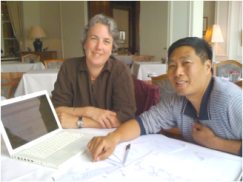By Drew Jones, Beth Sawin, and Stephanie McCauley
What has our impact been?
Eight people, dozens of partners, five years, and two simulation models — what does it add up to?
Here’s our informal assessment of how much of a contribution we’ve made to the global effort to curb climate change
Together with our partners, we see three big areas. We have:

1. Kept things honest. Our mentor Dana Meadows operated out of the theory that societies will only find fundamental solutions to the challenges we are facing when the escape hatches of wishful thinking have been closed, and we’ve been working hard to follow her lead. When, in the first week of the Copenhagen summit, some global organizations began proclaiming that success was close at hand, we re-grounded our global audience in biogeochemical realities and watched the “spinning” subside, with global effects. When, during the Durban summit, some parties argued that current pledges were good enough to meet climate goals, we ‘ran the numbers’ with clarity and precision, providing solid backing to the young people and climate advocates who were questioning such easy assertions (view our Durban results blog post). More recently, when voices rose to declare an energy miracle or natural gas bridge solution to climate, while dismissing efficiency and renewables, we ran the numbers, changed minds, and noted that the words of key thought-leaders changed as well.
“[Climate Interactive’s] software speaks numbers, not spin – and in the end it’s the numbers that count.” — Bill McKibben in the UK Guardian
2. Improved policy design by top decision-makers. We have helped powerful leaders advocate for sound long-term policy. We have made John Kerry better armed with scientific insight, Jonathan Pershing more exact, China’s climate ministry more able to reach targets, EU’s Jacquie McGlade more clear, Bill McKibben more numerate, international analysts empowered, Hal Harvey supported by modeling, the media more informed and millions of activists grounded in solid science.

3. Motivated, inspired, and empowered, creating new possibilities (while avoiding manipulation and zealotry). We have motivated action and reduced emissions through the hundreds of thousands of global professionals and citizens who have taught others with our tools (C-ROADS, C-Learn online, Scoreboard, iPad Pathways app, Climate Momentum, Bathtub), shown others our videos (Beth Sawin on the Scoreboard, Drew Jones on TEDx, Travis Franck’s webinar, John Sterman’s lecture), led their kids through our first or second science museum interactive exhibits, or lived a successful global climate deal through World Climate, our mock-UN “serious game” played around the world.
Not bad for eight people, dozens of partners, five years, and two simulation models. Let’s see what is next.
Please be in touch if you’d like to support our emerging work.







